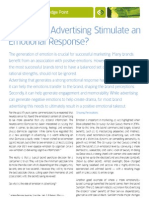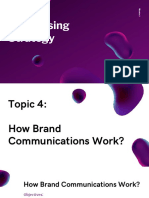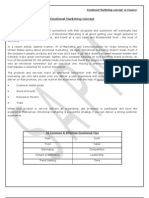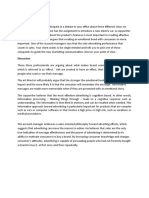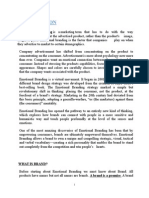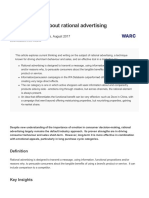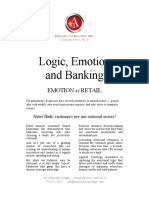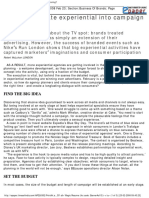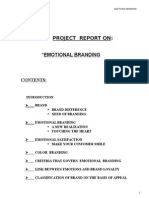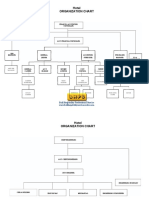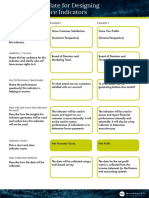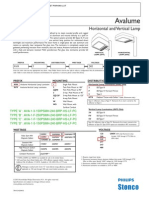Why do consumers remember and act on the advertising they witness?
In the beginning, advertising
recall mattered, right? It is likely that the undying support for recall was actually a conspiracy
orchestrated by manufacturers who believed more in functional messaging and less in the power of
the emotional bond advertising can create.
During the 2002 Advertising Research Federation conference, UniLever presented findings that
indicated that recall most strongly correlated with functional messaging, an element that historically
has not been a big driver in establishing ownable, differentiating equities for brands (which all
successful brand executives know is the key to long standing, successful positions in the
marketplace).
Another dated theory suggests that persuasion also mattersbut was the persuasion measure really
all that helpful? Historically, marketers havent seen much discrimination between advertisements
using traditional persuasion measures, nor have traditional methodologies accurately distinguished
between ads performance levels when they claim that an ad performs at, below, or above the
norm. Data suggests that it is the very rare case when ads perform statistically different from each
other in standardized testing.
Our experience testing ads for clients is that traditional purchase questions like: How likely would
you be to buy this product after seeing this ad? do a poor job of accurately reflecting how a consumer
really reacts after seeing an ad. Purchase questions dont do a good job of distinguishing between ads
in helping determine an ads ultimate success. As the chart below indicates, questions that more
appropriately measure the real behavior after seeing ads are more discriminating and more
appropriate measures of how a consumer reacts after seeing an ad. These should be used as a more
actionable discriminator when testing advertising.
�In the end, what matters most is how an ad shapes a consumers perception of the brand. This is not
to suggest that purchase doesnt matter, however it simply matters less, and successful brand
executives need to recognize this reality. The brands that succeed on a long term basis are those able
to form strong, differentiating emotional bonds with consumers. Without this bond, a brands relevance
and connectiveness with a consumer is not sustainabletoo much of a functional connection can
result in lost meaning, lost loyalty, and lost sales.
Take, as an example the following brands: Gee Your Hair Smells Terrific, Oldsmobile, and Wilsonall
brands that rested their fortunes on the value of their functional benefits and not the emotional
connection made with their target consumers. Where are they today? They certainly are not the
leaders in their respective categories. Without a more emotional messaging strategy, consumers had
a hard time understanding what made these brands different, why they should stay loyal to them when
comparable brands entered the marketplace, and how they possess a meaningful place in their lives.
On the flip-side, consider brands like Pantene, Volvo, and Nikeall brands that have not only pushed
functional messaging, but have done an excellent job building a relationship with their consumers,
making them feel like they are partners with the brand.
The challenge for most marketers and agencies today is: a) understanding what emotional messaging
is being transferred to the consumer and how this messaging impacts the perception of the brand; and
b) identifying what, if any changes are necessary to push the brands defining equity in the right
direction. Its one thing to have a well-defined creative brief, but completely another to unearth how an
�ad connects on a deeper emotional level and what this means for your brand.
What makes this so challenging is that consumers have a hard time expressing an emotional reaction
to an ad. When you ask a consumer what he likes or doesnt like about an ad, he usually dials down
into the executional components of the ad: I didnt like the way she looked, He seemed too fake to
me, That food looked really delicious.
And, most research methodologies today dont have a sound formula for unearthing the deeper
emotional connection made with an ad. In quantitative testing of this question, we have found that
consumers responses were quite functional and executional descriptionslacking emotion.
Absent of the ability to unearth these emotions, marketers and agencies are left with a huge void.
Without an understanding of how advertising impacts deeper consumer emotions, it will be impossible
for marketers to truly understand the long term, equity building impact of their advertising campaigns.
Consider another: Fortunately for the Lycra brand, it was able to unearth the deeper emotional
connections made by the ad campaigns it tested in a 2003 shootout. By using specific Unarticulated
Emotional Elicitation techniques, Lycra was able to unearth the central emotional drivers that have
since helped shape a more compelling and differentiating equity for the brand. (Disclosure:
Lycra/Dupont is a client of acuPOLL.)
As background, over the last five to ten years, Lycra has increasingly faced challenges from generic
offerings, making it harder, without stronger emotional messaging, to distinguish itself from the
competition. The charge for the three agencies involved in this shootout was to better create a
unique and ownable positioning for the Lycra brand. Successful agency executives and brand
managers alike understand the importance of consumer testing and developing this connection.
At the end of the day, the Lycra Has It campaign proved to be the most powerful of the three
campaigns tested, primarily for reasons of its ability to connect with consumers on a deeper emotional
level. Consumers played back feelings that suggested wearing Lycra would make them feel sexier,
more confident, more beautifulall benefits that consumers associate very positively with the brand.
The stronger emotional messaging helped consumers feel a greater sense of ownership with the
brand and more positive about what the brand had to offer.
Has It was launched in late 2003 and has thus far proved to be an effective campaign for the Lycra
brand. It served as the cornerstone for a major restage of the brand not only here in the United States,
but also in major markets worldwide.
�Overall, brand executives and researchers need to recognize that while testing is important, the quality
of the data gathered and how it is interpreted is critical to the success and longevity of the brand.
Methods can vary widely, but understanding how good ideas can be made better, particularly from an
emotional connection standpoint, will allow researchers to provide better and more actionable
information to the brand team. The team, in turn, will significantly increase its chances of success.
With a staggering number of new products on the market and an even more staggering amount of
failures, the use of an advertising methodology that goes beyond traditional measures to help assess
things like the deeper emotional impact of advertising, marketers will be more successful.
-----Mark Sneider, Senior Vice President at AcuPOLL, holds Masters degrees in Marketing and Economics
from the Kellogg Graduate School of Business at Northwestern University. Sneiders AcuPOLL
experience includes work in the food, financial and insurance services, pharmaceutical, durable
goods, and personal care categories.
http://www.brandchannel.com/papers_review.asp?sp_id=441
Read more: http://www.businessdictionary.com/definition/brand-recall.html#ixzz3SvN6guFC
C-ing is believing
Editors note: Isabelle Albanese is founder and principal of Consumer Truth Ltd., a
Hinsdale, Ill., research firm.
The ability to communicate clearly and to identify effective
communication has never been more important than today in our
hectic, fragmented world. And while there are undoubtedly thousands
of books written, papers published and philosophies espoused about
how to communicate effectively, Ive developed a simple framework
called the 4Cs of Truth in Communications, which was designed to
offer researchers and clients a way to objectively evaluate consumer
response to stimulus.
Using a template weve created, which is explored below, clients follow
consumer feedback easily by instantly assessing how the stimulus
performs on each of the Cs. When it comes time for the debrief, all of
your clients have a consistent format for structuring feedback, which
makes the debrief session flow very smoothly.
The 4Cs process was developed eight years ago for a presentation of
insights to a new campaign idea for a venerated brand. The clients in
the room appreciated the way we categorized the learning. The 4Cs
structure enabled everyone at the table, from sales people to
promotion people to HR, to understand the learning in a way that
made sense. And the ad agency creative folks felt it was an objective
way to think about consumer reaction to advertising ideas. Having
spent 16 years in the ad agency business working with creatives, I can
tell you this was a personal victory! They are not easy to please,
especially when it comes to listening to consumers evaluate - not
always in a generous way - their babies.
The 4Cs are: comprehension, connection, credibility and
contagiousness. Together they capture what everyone connected with
the project needs to know about consumer response to stimuli.
Separately, they provide clarity for ourselves and our clients, and a
simple way to categorize consumer response.
They form a model in which you ask a series of questions about how
the consumer responded to stimuli. In the answers (as well as an
understanding of how to use the model) lies the direction you and
your client are looking for to move forward.
Comprehension
Questions: Is the main message clearly communicated? Simply put,
do consumers get it?
The comprehension C is exactly what you think it is - theres no hidden
meaning or great deal of explanation necessary, although it is
obviously quite fundamental to basic communication. On the surface,
this is a simple assessment of whether the intended message is being
understood. Simple, in theory, but not always easy to achieve,
because sometimes marketers and advertisers seem determined to
make consumers work exceedingly hard just to get the message. How
many times in showing advertising to consumers have you heard them
say with frustration, What are they trying to say to me?
Consumers just dont have the time. No matter what category were
delving into - from ice cream to clothing to coffee, shampoo or
insurance - consumers are basically saying to us, Please dont make
me work that hard. I am very busy. Theyre perfectly willing to listen
to your message. In fact, many want to hear it. They just dont want
to work hard to get it.
Connection
Questions: Does the message resonate with consumers? Is it
persuasive? Does it communicate that the brand knows them simply
by the way it is talking to them? Does it motivate purchase?
These are all critical questions in determining the extent to which any
form of communication connects with its intended audience.
Connection is often an emotional response - something that is felt but
cant be explained. A genuine rapport has been established, so its no
longer advertiser talking to customer or politician to voter, its a
message from someone who really knows me and understands what
matters to me. So much so that I feel that the message is speaking
directly to me on a personal level.
Connecting with the consumer means you have begun to establish a
relationship with them via your communication. And how valuable is
that? It means something you said or showed to them has resonated has reached them on some internal level, whether thats in a rational
or irrational way - and so the communication resonates too.
The message somehow has tapped into an existing consumer truth for
them in their lives relative to the subject, and it usually always
extends deep downward to something emotional, or at the very least,
something which is not entirely rational: frustration, excitement,
anger, passion, joy, happiness, sadness, resignation, etc.
I once worked on communications evaluation for a Suave hair care
campaign. At the time, we were aiming to communicate a completely
new message based on a new positioning and tapping into a newlydiscovered consumer truth. Four print ads depicted mom (the target)
in various family situations:
in the kitchen multitasking by making a PB&J sandwich while having
a phone conversation - with her kids all around her doing various reallife kid-type things;
in the bathroom sitting on a (closed) toilet and helping her threeyear-old with potty training while her four-year-old is brushing his
teeth;
in her daughters bedroom playing dress-up;
in the hallway helping her young daughter get her boots on.
All were very plausible, real-life situations. Of course, you say, if you
hold a mirror up to someone they are likely to say I can see myself!
So what? That doesnt necessarily mean they like what they see, are
moved emotionally or otherwise motivated by that image. To be sure.
But in this case, it did mean that. One mom looked at those four ads
and said, literally as she pointed to each one of them, Thats me,
thats me, thats me and thats me!
The connection wasnt made simply because she could see herself in
those situations - and heres the interesting, brand-relevant part - it
was made because she saw that each of the moms depicted had
great-looking hair. She was able to connect with the message that
even though Im a mom and have a crazy, chaotic mom life, using
Suave can help me look good!
And the beautiful epilogue to this story is that in subsequent
quantitative ad testing, these ads met all client hurdles for attention,
branding, communication and motivation. And the Suave hair care
brand experienced share and sales growth.
Credibility
Questions: Does it make sense for the brand to speak to consumers in
a certain way? Is the tone and manner consistent with the brands
position in consumers brain space based on their experience with
and understanding of the brands equities and promises? How do you
know?
If the message isnt credible, if it doesnt conform to the brands (or
causes or platforms) truth, its meaningless. The audience needs to
believe who is saying it (e.g., the brands voice), what is being said
and how its being said. Otherwise any connection previously
established immediately begins to break down. And I really mean
immediately.
Who: Does it make sense for your brand to speak to its audience in
this way? Does it logically fit, given the equity your brand has
developed among its core target and in the marketplace as a whole?
What: Is it something your audience expects from this brand? This
could be good and bad. If its something expected, it could likely get
glossed over or even ignored outright. It may fit, but if its just sameold, there better be enough going on in the areas of communication
and connection (and contagiousness, the 4th C) to make up for toosmooth a fit.
How: An unexpected message or delivery can bring a lot of energy
and attention to your brand, especially if its history or heritage or
equity gives it permission to speak in this way. Or even if it doesnt, it
can still be powerful if marketplace conditions and consumer attitudes
make it acceptable anyway.
The point is, credibility leads to believability and believability leads to
persuasion and persuasion leads to action. So even if its not instantly
credible, it becomes credible because your audience can see a way to
make the message fit. That counts too.
The credibility C is all about your brands truth. Its either going to
work for consumers or it isnt. For a message to really drive the
credibility train, it must make sense for your brands message to be
communicated in that particular way. It gets an immediate head-nod.
Not a trace of doubt in my mind. When credibility is there, it removes
a potential obstacle to comprehension, connection and
contagiousness.
In fact, when its instantly credible, consumers dont even think about
it. They dont usually look at an ad or package or concept which is
delivering a credible brand message and say Yes, that is a believable
message from that brand. In most of the work we do, credibility of
the message is not an issue. Most clients know their own brand truth.
Its the fiber of their brand. Its been built up and ingrained in
consumers brains and psyches over time.
Contagiousness
Questions: Is there a sense of energy around the message and the
way it is executed? Does it offer a new way to view the brand or
category? Is it competitively differentiating? Is there something
innately memorable about it? Does it evoke a vivid emotional
response? Might it have talk potential (it may not always be positive
talk)? Does it motivate the target to do something? Does it elicit some
kind of highly-charged, demonstrable and visible reaction?
This C is tricky. Tricky, but incredibly necessary. In many cases, it can
be all that truly matters.
You know how it is when the room starts buzzing, when the
respondents start talking among themselves about what theyve just
seen. Thats when you know the communication is on its way to
becoming an unqualified success.
Ive found that contagiousness, in the positive sense, is often
intimately linked to connection. When a message truly resonates with
its audience in a profound way, there tends to be a residual
contagiousness effect. They simply cant help thinking about it or
mentioning it in conversation. Remember my Suave example - Thats
me, thats me, thats me! For that moment, right there in the room,
that woman got excited about the message. She spoke out, her voice
rose, she pointed to each ad - she was infected. The brand had found
an idea that not only resonated with its target: Moms want pretty hair
too! - but executed it in a way that left the recipient feeling
empowered and excited by the message. The Suave brand now has
the opportunity to sink in with this target - to infect the way they
think about the brand. Thats contagiousness.
Immediately actionable
No matter what the stimulus, applying the 4Cs can help identify if it
really rocks and why, or where it needs help to keep from sinking like
a rock. The method is immediately actionable - you can use it in your
very next project that involves stimulus exposure.
Its also a way to get disparate constituents (brand clients, consumer
insights clients, ad agencies, etc.) on the same page relative to
evaluating consumer feedback - something that can always be a
challenge.
The simplicity of the framework is its power; it is easy to remember
and easy to use. It can lead to better creative executions and stronger
business results.
�Hence, there are 3 steps in the process of showing how advertising works:
The key measure of accountability for advertisers is really all about how the potential customer
reacts to the advertising.
http://mcnair.com.au/expertise/advertising-effectiveness-research/






